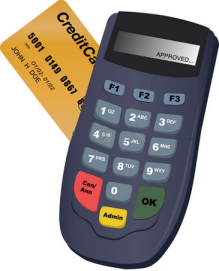A significant piece of the increased banking regulation set forth by the Dodd-Frank Act and the Durbin Amendment will go into effect October 1st, 2011. Banks have responded by exploring all different types of new fees and potential revisions to terms and conditions agreements. One such potential revision could put a cap on the total amount consumers spend per debit card transaction at $100, forcing them to pull out their credit card instead for large transactions. With this new legislation, let’s investigate who is the likely beneficiary: banks, the consumer, or retailers.
 Debit Card Interchange Fees Cut in Half for Retailers
Debit Card Interchange Fees Cut in Half for Retailers
The Federal Reserve board recently voted to reduce the amount of debit card interchange swipe fees banks could charge retailers per transaction from $0.44 to around $0.21. If you’re a retailer, this means the fees banks charge you for debit transactions should be cut in half starting on October 1st, 2011. This will translate into at least a $10 billion reduction in total fees banks charge retailers (2009 Nilson Report). In response, banks have already started to explore revisions to customer agreements with the intention of limiting their exposure to this now less profitable source of revenue. One such potential revision is to put a cap on the amount that consumers can spend per debit card transaction to the $50 to $100 range. The idea for banks is that since the debt card swipe fees will be half of what it used to be, let’s limit spending on debit cards to a lower dollar amount and transfer larger spending to credits cards which will be more profitable.
A $3 Fee Could Be Coming to a Debit Card Near You
Wells Fargo will roll out a pilot program starting on October 14th to charge certain debit card holders $3 per month for using a debit card in addition to regular checking account fees. The program will only be rolled out in Georgia, New Mexico, Nevada, Oregon and Washington. It may sound like chump change to you but if the fees were to go into effect for all of Wells Fargo debit card customers, it would likely generate $120 million in revenue per month or $1.44 billion a year based on the estimated 40 million debit card holders at Wells Fargo. So far, Chase is the only other major bank to explore such a program but the jury is still out on the success of it. If the programs are a success and customer retention remains high, we can almost guarantee you that other banks will follow suit.
Who Benefits from the latest legislation?
In the short-term, retailers will likely get a $10 billion break, but in the end it doesn’t look like they’ll be a clear winner. Here’s why. The savings from the reduced debit card swipe fees banks charge retailers were designed to be passed onto the end consumer. That’s wishful thinking with many businesses continuing to be stretched thin in a deteriorating economy. In addition, banks are already exploring other fees to charge customers and retailers know that so they’d be hesitant to give the customer a break when they can be hit with another fee in the future. Finally, historically banks have a strong track record for finding ways to recoup lost revenue and we don’t think this time will be much different.
More Personal Finance Questions? Browse Answers or Ask a Financial Professional Online.
Related Articles
->Banks May Soon Charge For Savings Accounts
->Is My Bank Account FDIC Insured?
->The Best Bank For Small Business Checking and Savings
->More Debit Card Fees Coming
->Avoiding New Bank Fees
->More Debit Card Fees Coming
->Don’t Opt-In to Overdraft Protection


